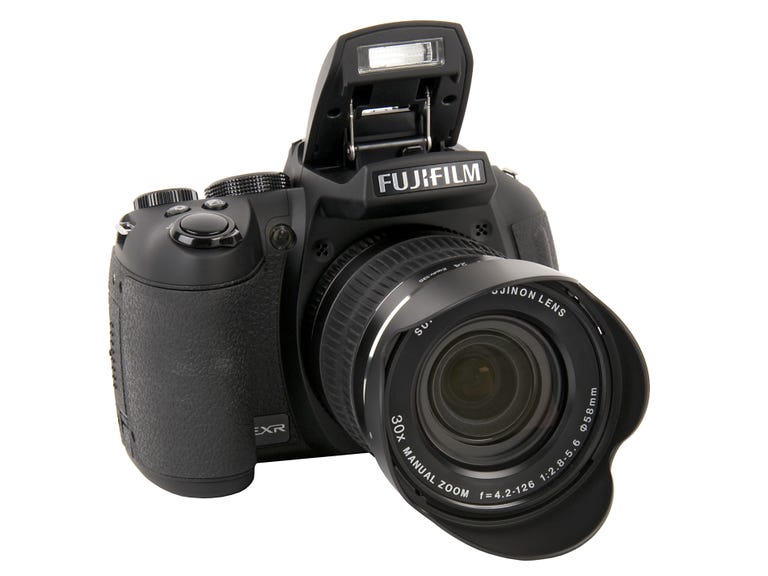 Why You Can Trust CNET
Why You Can Trust CNET Fujifilm FinePix HS30 EXR review: Fujifilm FinePix HS30 EXR
With a high resolution and an extraordinary zoom, the FinePix HS30 EXR is a worthy addition to Fujifilm's already strong semi-pro line-up.
If you were tempted by the five star-rated Fujifilm X-S1 and haven't yet indulged yourself, hang tight for the next 1,200 words.
The Good
The Bad
The Bottom Line
The Fujifilm FinePix HS30 EXR outguns the X-S1 in several respects, with a higher resolution and 30x zoom. Compare it with a regular 35mm film camera, and the glass in this device delivers the same effect as a 24-720mm lens. Not only would that be heavy and bulky on a regular dSLR, it would also be prohibitively expensive, but the HS30 EXR delivers it in a small, light body for around £380.
The question is whether this makes it not only different, but better than its chunkier sibling.
Design and build
So what's it like to use? In a word, lovely. The controls move freely, with little resistance, but snap neatly into place so you don't sweep past the settings you want. There's a fine balance to be struck between dials so rigid they're uncomfortable, and so lacking resistance they're easy to knock unintentionally. On the HS30 EXR, Fujifilm has got it spot on.

Indeed, my only complaint in respect of its build is the siting of the focus ring, which sits behind the zoom control cuff, a little too close to the body for comfort. However, its integration with the camera's firmware is excellent. Switch to manual focus and twist the ring and it not only enlarges the central portion -- a common approach -- but overlays it with a live bar graph showing how close you are to achieving what it considers a pin-sharp focus. That's useful if you have trouble judging it by eye.
There are controls everywhere, with the familiar focus, exposure, sensitivity and white balance buttons I saw on the X-S1 running down the left of the screen. There's a regular four-way controller to the right. A multi-function control wheel is situated on the top of the body, which changes the active variable for whichever shooting mode you've selected. In aperture and shutter priority mode, that obviously means the aperture diameter or shutter speed. Switch to manual though, and you can control both of these, alternating between them with a quick press of the exposure compensation button.
The 3-inch screen is bright, fine-grained and refreshes smoothly. It's articulated to tilt up and down, which makes overhead and low shots easy. It's not until you've got used to a camera with this feature and switch back to one that hasn't that you realise how much you come to rely on it. It may sound like a gimmick but it isn't. In my book, it's a very firm tick in the 'reasons to buy' column.
There's also an eyepiece monitor rather than an optical view through the lens. This isn't quite as smooth to refresh as the rear LCD, but it is fine grained and sharp enough to replicate the camera's regular menus, so you don't need to take it away from your eye when tweaking your settings. A sensor beside it detects when you've brought it up to your face and switches from LCD to eyepiece, while a diopter -- a small dial connected to the viewfinder -- on the other side lets you move it back and forth until you find a comfortable focal position.
It's not just the hardware that's constructed well. The menus are too. Everything's easy to find and there's plenty of help dotted around. Switch to panorama mode and a horizontal line helps you stay level as you sweep across the scene, while switching between the various film simulation options throws up a short description for each one. Astia, for example, has 'softer colour and contrast for a more subdued look', while Velvia delivers 'vibrant reproduction, ideal for landscape and nature'.
The shooting specs are up there with the best. Native resolution is 16 megapixels, producing 4,608x3,456-pixel images. At that resolution, sensitivity ranges from ISO 100 to ISO 3,200. If you want to push it to ISO 6,400, the resolution halves. In the unlikely event you want to take it to ISO 12,800, it's halved again to just 4 megapixels. Compensation is +/-2EV in 1/3EV increments.
Shutter speed runs from 1/4,000 second to 30 seconds in manual mode, at the longer end of which you'll be able to capture some great night-time shots with streaking headlights and illuminated buildings. Maximum aperture is an appreciably wide f/2.8 at wide angle, allowing for some great detailed shots with a rapid fall-off in focus, and a still respectable f/5.6 at full telephoto.
Stills tests
So how does this translate into photos? I tested the HS30 EXR on a very mixed day, with both rain and direct sun, and results were generally impressive.
Focus was nice and snappy which, combined with the smoothly geared zoom mechanism, made it easy to get the shot I was after in every instance. Even at maximum zoom, it was easy to isolate the subjects I wanted in focus, thanks to the fairly generous maximum aperture.
It's very easy to fix your focal point by setting the focus mode to Area and using the four-way controller to position it, which saves you reframing after you've set your focus. Alternatively, for sports and wildlife photography -- or indeed, kids -- there's a tracking mode which, once set, will follow your subject for as long as you keep them in the frame.
Macro performance was excellent. Supermacro lets you put the lens just 1cm from the subject, but even regular macro, which takes you to 7cm, has no trouble clearly isolating the subject from its surroundings.
Detail is excellent and the focal area is very tight. There's a quick fall-off in focus, thanks to the f/2.8 maximum aperture, which really draws the eye to the subject. In the image below, the focus is sufficiently tight that while the main bulk of the stamen in this flower is sharp, the pointed ends to the right are just starting to blur.
Colours were reproduced extremely well under all lighting conditions. Flowers can be tricky to expose accurately under direct sunlight as they can be a little too vibrant. However, even the brightest of these pansies, which as the shadows reveal were shot under just those conditions, are accurately captured, with plenty of sharp contrasts in the focal area.
At the other end of the spectrum, when shooting more muted colours under overcast skies, the HS30 EXR barely seemed to notice the change in conditions. The shot below was captured while it was still raining. Despite very little variation in the colour of the petals, the results have plenty of detail, with veins clearly visible in the petals and the petal texture particularly clearly rendered in the raindrop.
Overall, I was very impressed by the results achieved by the HS30 EXR, and the overcast conditions helped to illustrate the effectiveness of Fujifilm's EXR system, which can be set to prioritise resolution, high sensitivity with low noise, or visible detail, depending on your preference. Alternatively, you can leave it up to the camera to decide on a case-by-case basis.
The two alternating images below were shot within 10 seconds of each other, under identical conditions, but with very different results. Both were exposed at 70mm focal length (35mm equivalent) for 1/160 second at f/3.6, yet one is clearly more vibrant and appealing than the other. The better image is the one shot using the HS30's EXR mode, which selected ISO 160. The washed-out image used auto mode, which selected ISO 320.
However, there's a caveat. Switching to EXR removes the ability to lock the camera into the highest resolution shooting mode. You can still lock it into medium or small, but you can only shoot full-resolution images if the camera deems the current conditions suitable. In this case, it didn't, and my overcast EXR shots were output at 8 megapixels.
Video test
The HS30 EXR shoots at both 1,920x1,080-pixel resolution and 1,280x720 HD video at 30 frames per second, each with stereo sound. If you're only shooting for web use, you can downsize this to 640x480, 320x240 or 320x112 pixels if you want to save space.
The results are excellent, with the soundtrack in particular being very clear and cleanly recorded. There's no motorised zoom, so you'll have to adjust this manually if you want to change the focus. It takes some practice to do this while filming without undue shake -- you'd be wise to use a tripod. It's possible to faintly hear the movement of the lens on the soundtrack, as well as a small knock if you run the lens to the end of its channel.
The only disappointment was the speed at which it compensated for extreme oncoming changes of light, as can be seen at the start of my sample video, below.
Conclusion
In many respects, the HS30 EXR and X-S1 are very similar cameras. They both look and work like a captive-lens dSLR, they have similar controls and broadly similar features.
However, the HS30 EXR is around two-thirds the weight, noticeably smaller and considerably cheaper. It also shoots 16-megapixel images, where the X-S1 tops out at 12 megapixels, and it has a longer zoom. That makes the HS30 EXR the better camera, right? Not necessarily.
The HS30 EXR's shots may have a third more pixels than the X-S1, but when you do the maths, the difference equates to less than the resolution of a 640x480-pixel web graphic -- the kind of thing you'd have snapped on the earliest digital cameras 12 or more years ago. The HS30 EXR arranges these 16 megapixels on a 1/2-inch sensor, whereas the X-S1 spreads its 12 megapixels over a more roomy 2/3-inch chip. That means each one can be larger, and so more effective, so you can take full-resolution shots at higher sensitivities -- up to ISO 5,000.
Where pros are concerned, the X-S1 remains the better choice, but that should in no way put you off the HS30 EXR. It's a great camera, fun to use and with a very generous range of well-thought-out, easy-to-use controls.
Anyone looking for a halfway house between an ambitious pocket snapper and dSLR will be very happy with the flexibility and features this camera delivers.


